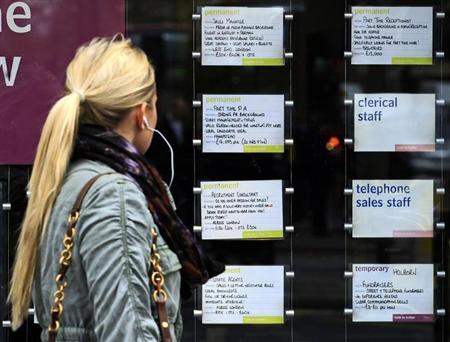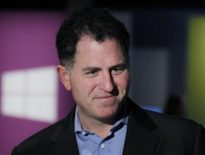(Reuters) – Britain’s unemployment rate fell unexpectedly in July to its lowest since late last year, adding to bets in financial markets that the Bank of England might raise interest rates earlier than it has suggested.

The Office for National Statistics said on Wednesday the rate dipped to 7.7 percent in the three months ending in July from 7.8 percent previously, as the number of people without a job on the ILO measure dropped by 24,000 to 2.487 million.
That was the lowest jobless rate since September-November 2012.
In another sign of surprising strength in the labor market, the number of people claiming jobless benefit – a narrower measure of unemployment – fell by 32,600 in August. Economists taking part in a Reuters poll had expected a drop of 22,000 from July.
July’s fall was also revised to show a drop of 36,300 – the steepest decline since June 1997.
The jobs data has taken on a new significance since the BoE, keen to encourage spending and investment, pledged last month to keep benchmark borrowing costs low as long as the ILO unemployment rate remained above 7 percent.
The central bank predicts that this key rate will fall sharply next year before easing more gently to stand just above 7 percent in the third quarter of 2016.
However, investors reckon that joblessness will come down more quickly and are pricing in the first rise in interest rates in December 2014.
Such bets have led to rises in a range of market interest rates, including those that usually feed through to mortgages and other loans.
Last month Bank of England Governor Mark Carney estimated that about 750,000 jobs would need to be created over the next three years for unemployment to fall to 7 percent.
Forecasting the path of Britain’s unemployment rate has been complicated in recent years by older workers rejoining or remaining in the labor force, job cuts in the public sector and uncertainty about immigration levels.
The ONS said on Wednesday public-sector employment fell in the second quarter by 34,000 to 5.665 million.
The BoE believes the jobless rate will on the whole fall slowly as firms squeeze more out of their current staff as the economy picks up. Surveys of British services and manufacturing last month backed up that view as employment grew more slowly than overall activity.
But stronger productivity is unlikely to boost real wages anytime soon: the ONS said average weekly earnings growth including bonuses slowed to 1.1 percent in the three months ending in July compared with a year earlier. Excluding bonuses, pay grew 1.0 percent.
By contrast, British inflation averaged 2.8 percent over the same period.
So far, BoE policymakers have appeared unperturbed by markets’ reaction to their forward guidance on interest rates.
In a newspaper interview on Sunday, Paul Fisher, the bank’s executive director for markets, said households and businesses seemed to be “getting the message” that rates would stay low for a while yet, even though markets might need more persuading.
BoE Governor Carney has also stressed that his flagship guidance policy is not reliant on how financial markets respond.
(Reporting by Olesya Dmitracova and William Schomberg)





